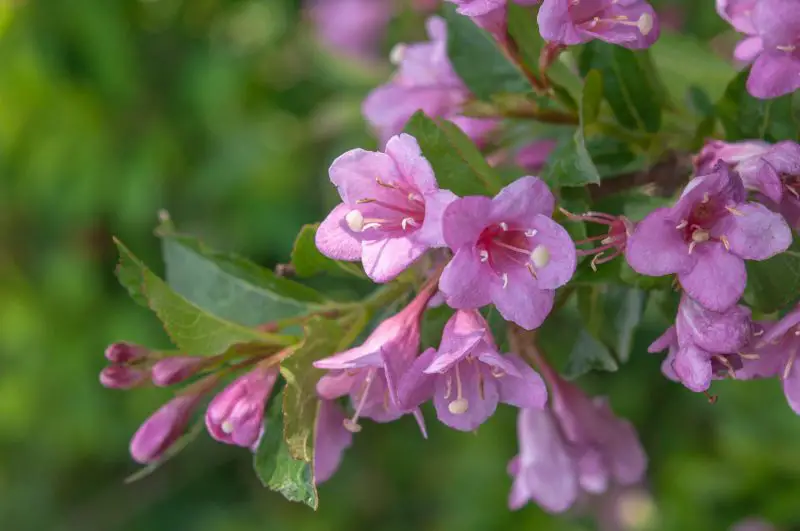Weigela is a beloved shrub admired for its vibrant trumpet-shaped flowers and ability to transform any garden with bursts of color. Blooming seasons are the highlight of this plant, drawing attention from both gardeners and pollinators. The graceful arching branches covered in blossoms make it a versatile choice for borders, hedges, and focal points in landscapes. Understanding when this beauty blooms is the key to enjoying its charm to the fullest.
Knowing the right blooming period allows gardeners to plan seasonal displays and extend floral interest throughout the year. This guide will not only answer the question “When do Weigela bloom?” but also provide proven tips for maximizing color and longevity. With proper care, your garden can enjoy radiant flowers that return stronger and brighter each season.
Understanding Weigela and Its Blooming Cycle

Weigela is a deciduous shrub that originated in East Asia and has become a garden favorite worldwide. It is admired for its arching stems and clusters of trumpet-shaped flowers. The plant is easy to grow, making it suitable for both beginners and experienced gardeners. It offers long-lasting foliage interest along with its stunning blossoms, which makes it a valuable choice for diverse landscapes.
The blooming cycle of Weigela usually begins in late spring and often extends into early summer. During this period, the shrub produces abundant flowers in shades of pink, red, or white. Some modern varieties are bred to bloom more than once, offering a second flush of color in mid or late summer. These repeated blooms enhance the appeal of the plant and provide more opportunities for enjoyment.
Understanding the natural rhythm of Weigela helps gardeners anticipate its peak beauty. By recognizing when flowering starts, you can plan maintenance tasks such as pruning and feeding. Timing also ensures that you do not accidentally cut off flower buds before they open. Knowing the bloom cycle gives you control and confidence in your gardening decisions. With this knowledge, your Weigela can thrive and reward you with dazzling flowers each year.
When Do Weigela Bloom in Different Regions
The blooming period of Weigela varies depending on climate and region. In colder northern areas, the shrub usually starts flowering later in spring. Frost and cooler soil temperatures slow down growth, delaying the appearance of buds. Once the weather warms consistently, the plant quickly produces its vibrant display of trumpet-shaped flowers.
In moderate climates, Weigela tends to bloom earlier and may continue flowering longer. These regions provide steady spring temperatures that encourage faster bud development. Some modern cultivars in these areas even offer a second flush of flowers during mid to late summer. This extended cycle makes Weigela especially attractive for gardeners seeking longer seasonal color.
In very warm or southern climates, the bloom period often begins early in spring. Weigela may also produce sporadic flowers later in the year if cared for properly. However, extreme heat can shorten the intensity of each blooming phase. To achieve lasting color, gardeners in warm regions must provide consistent watering and protection from strong afternoon sun. This helps maintain plant vigor and ensures reliable blooms every season.
Factors That Influence Weigela Blooming
Sunlight and Location
Weigela is at its best when placed under bright conditions. At least six hours of direct sunlight each day allows the shrub to reach peak bloom. Plants that receive insufficient sun often struggle with weak branches and reduced flower sets. Gardeners sometimes notice that shaded Weigela produces more leaves than blossoms, which can be disappointing. The energy from sunlight fuels photosynthesis, providing strength for both growth and vibrant flower production. Without it, blooming potential is limited, no matter how well the plant is fed.
The choice of location is therefore crucial for long-term success. South-facing gardens often deliver the best results, while east-facing areas can also work well. West-facing spots may be ideal in cooler regions but need extra care in hotter climates. Placing Weigela near reflective walls or light-colored surfaces can even boost brightness and enhance flowering. However, avoid areas where larger trees or fences cast long shadows, as this will reduce flowering dramatically. A balance of sunlight, space, and airflow provides the perfect setting for this shrub to flourish and put on a brilliant display each season.
Soil and Nutrition
Healthy soil lays the foundation for a blooming Weigela. Well-draining soil enriched with organic matter ensures roots stay strong and able to absorb nutrients. Gardeners often mix compost, leaf mold, or aged manure into planting holes to provide natural fertility. Poor soil, whether heavy clay or overly sandy, limits root function and reduces flower development. Clay retains excess moisture and may cause rot, while sandy ground drains too fast and leaves roots starved. A balanced soil texture provides the steady moisture and nutrition needed for vigorous flowering.
Feeding plays a major role in promoting healthy blooms. A slow-release fertilizer applied in early spring supplies steady nutrition throughout the growing season. Formulas high in phosphorus and potassium encourage stronger bud formation and more vibrant colors. Overuse of nitrogen should be avoided, as it pushes leafy growth at the expense of flowers. Mulching with compost or shredded bark keeps soil fertile while conserving moisture. Regular soil testing also helps gardeners adjust feeding practices and maintain proper pH levels. With nutrient-rich soil and balanced feeding, Weigela produces lush foliage and blossoms that brighten the garden year after year.
Watering Practices
Consistent watering keeps Weigela vigorous and encourages steady flowering. Inadequate moisture during bud development leads to fewer and weaker flowers. Gardeners in dry climates may notice reduced blooms if watering is irregular. On the other hand, overwatering creates soggy soil that suffocates roots and invites fungal diseases. Finding the right rhythm is essential, with deep watering proving far more beneficial than quick, shallow drinks. When water penetrates deeply, roots stretch downward, gaining resilience against future droughts.
To maintain proper moisture, water once or twice weekly depending on weather conditions. Mulching around the base of the shrub helps conserve water and stabilize soil temperature. During heat waves, plants may need additional hydration, especially if grown in containers. Drip irrigation systems or soaker hoses work well, as they deliver water slowly and directly to roots without wetting foliage. This reduces the risk of leaf diseases and ensures nutrients travel efficiently into the plant. By monitoring soil moisture carefully and adjusting watering habits with the season, gardeners can support lush foliage and continuous, colorful blooms throughout spring and summer.
How to Encourage Longer Blooming Periods
Proper Pruning for More Flowers
Pruning is one of the most effective ways to extend the bloom period of Weigela. This shrub produces flowers on old wood, meaning buds form on stems from the previous season. If pruning is done too late, many buds may be removed, resulting in fewer blossoms. To avoid this, prune immediately after the first bloom in late spring. Removing spent branches encourages the plant to push new growth, which may produce another flush of flowers in summer. Careful timing ensures maximum bloom without sacrificing plant health.
Shaping the plant also plays a role in prolonging its beauty. Thinning out crowded stems improves airflow and allows sunlight to reach the inner branches. This reduces the risk of disease and helps more buds develop across the shrub. Light trimming of faded flowers stimulates new shoots, which often bear blooms later in the season. When done correctly, pruning not only maintains a neat, attractive form but also keeps Weigela productive for many years.
Fertilization Techniques
Feeding Weigela with the right nutrients is essential for extending its blooming season. A balanced, slow-release fertilizer applied in spring gives the shrub steady nutrition. Formulas with more phosphorus and potassium promote strong bud formation and improve flower color. Avoiding excess nitrogen is important, as it favors leafy growth while reducing bloom production. Proper nutrition at the right time ensures the plant has enough energy for both foliage and repeated flowering.
Supplemental feeding during midsummer can encourage additional blooms. A liquid fertilizer diluted to half strength provides a quick boost without stressing the roots. Incorporating organic matter such as compost or well-rotted manure also supports long-term soil fertility. Mulching not only enriches the soil but also conserves moisture, which is crucial during hot months. By combining slow-release feeding with seasonal supplements, gardeners can keep Weigela healthy, vigorous, and colorful well beyond its usual bloom cycle.
Deadheading Spent Blooms
Deadheading is a simple yet powerful technique to prolong Weigela flowering. When old blossoms are left on the plant, energy is directed toward seed production rather than new blooms. By cutting off faded flowers, you redirect the plant’s resources back into producing fresh buds. This method is especially effective with repeat-blooming varieties, which respond quickly to deadheading. Regular attention to spent blooms can make the difference between a short display and weeks of continuous color.
Deadheading also improves the overall look of the shrub. Removing dried flowers keeps the plant tidy and highlights the vibrant new blossoms. It is best to cut just below the faded cluster, taking care not to remove healthy growth. Combined with light pruning, this practice stimulates new shoots that may carry additional flowers later in the season. Consistent deadheading throughout spring and summer rewards you with a healthier plant and a garden filled with lasting color.
Common Blooming Problems and Solutions
Why Weigela Fails to Bloom
One of the most common concerns among gardeners is a Weigela shrub that fails to bloom. Several factors can contribute to this issue, but pruning at the wrong time is the most frequent cause. Because Weigela sets its flower buds on old wood, cutting it back in late fall or early spring often removes those buds before they can open. In such cases, the plant may appear lush and healthy but will not produce flowers. Another reason is insufficient sunlight. A Weigela placed in too much shade cannot gather enough energy to develop blossoms, resulting in few or no flowers.
Nutritional imbalance also plays a role in reduced flowering. High nitrogen levels encourage rapid leaf growth, leaving little energy for blooms. Poor soil, water stress, and extreme weather can add more stress, limiting the plant’s ability to flower. To solve the problem, prune only after flowering, provide at least six hours of direct sunlight, and use balanced fertilizer formulas. Improving soil with compost and mulching also helps maintain consistent moisture. With these adjustments, most struggling Weigela shrubs will recover and reward gardeners with abundant flowers in the next season.
How to Revive Weak Blooming Plants
A Weigela that produces weak or sparse blooms may not be completely lost. With proper care, the shrub can be revived and encouraged to flower again. The first step is to evaluate its growing conditions. If planted in poor soil or heavy shade, consider transplanting it to a sunnier spot with improved drainage. Once established in a better environment, the plant often shows significant improvement. Regular watering during dry periods also supports recovery, as stressed roots cannot sustain vibrant flowering. Consistency in moisture helps the plant regain energy for bud formation.
Pruning is another important step in rejuvenation. Removing dead or old wood allows new shoots to develop, which increases the chance of future blooms. A gradual renewal pruning over two to three years can restore vigor without overwhelming the plant. Adding organic mulch enriches the soil and keeps root zones cool in hot weather. Applying a phosphorus-rich fertilizer in spring also supports bud development. With patience and attentive care, even a weak Weigela can bounce back and transform into a colorful, flourishing shrub once again.\
Varieties of Weigela and Their Blooming Seasons
Early Blooming Varieties
Certain Weigela varieties are known for their early blooming period, often starting in late spring. These types bring a burst of color just as other shrubs are beginning to wake from winter. Their flowers usually appear in shades of pink, red, or soft pastels, making them a cheerful addition to the garden. Gardeners who want early-season impact often choose these cultivars to provide interest before summer perennials take over. Early bloomers help create a staggered sequence of color across the growing season.
An example is Weigela ‘Minuet,’ a compact variety that produces abundant flowers early in the season. It grows well in smaller gardens and works beautifully in borders or containers. Early blooming varieties thrive when planted in sunny locations with fertile soil. Since they bloom before the heat of summer, consistent spring watering is especially important. With proper placement and care, these cultivars reward gardeners with dependable, vibrant flowers at the start of the season.
Repeat Blooming Varieties
Modern breeding has produced repeat blooming Weigela varieties that flower more than once each year. These shrubs usually have an initial flush of flowers in late spring, followed by additional blooms in midsummer or early fall. Their ability to provide color for a longer period makes them highly desirable for both home gardens and public landscapes. Repeat bloomers offer a dynamic display that changes throughout the season.
One of the most popular is Weigela ‘Sonic Bloom,’ which is known for its impressive repeat flowering habit. Gardeners appreciate this type for the extended period of color and its adaptability in many settings. To maintain consistent reblooming, deadheading spent flowers and providing balanced feeding are essential. Regular watering during hot months also supports new bud formation. With these care practices, repeat blooming varieties keep the garden lively and colorful long after many other shrubs have stopped flowering.
Dwarf Varieties and Their Flowering
Dwarf Weigela varieties have become favorites for small gardens and container plantings. These compact shrubs typically reach only two to three feet in height but still produce a generous amount of flowers. Blooming often begins in late spring, with some types offering scattered blooms into summer. Their manageable size makes them ideal for borders, patios, and foundation plantings. Despite their smaller stature, they provide the same vibrant color as larger varieties.
Weigela ‘My Monet’ is a popular dwarf cultivar with variegated foliage and pink flowers. It combines colorful leaves with seasonal blooms, adding multiple layers of beauty to the garden. Dwarf varieties are easy to maintain since they rarely require heavy pruning. They thrive in sunny spots with well-drained soil and respond well to light feeding. With minimal effort, these compact shrubs deliver reliable color and fit perfectly into limited spaces or decorative garden designs.
Varieties with Unique Bloom Colors
While many Weigela varieties feature pink or red blossoms, breeders have developed types with unique and striking colors. Some cultivars display deep purple, soft yellow, or even bicolor flowers that stand out in the landscape. These unusual shades add contrast to traditional plantings and create eye-catching combinations when paired with other shrubs or perennials. Unique-colored Weigela varieties provide gardeners with more creative options in garden design.
For example, Weigela ‘Ebony and Ivory’ features dark foliage paired with creamy white flowers, creating a bold visual contrast. Another standout is Weigela ‘Golden Jackpot,’ which has bright yellow foliage and pink flowers. These distinct varieties still follow the typical blooming pattern of late spring with possible summer reblooming. Gardeners who want something beyond the traditional pink can choose these cultivars for added diversity. With the right care, they offer reliable blooms and a striking presence in any garden setting.
Seasonal Care for Lasting Color
Spring Care for Vigorous Growth
Spring is the most active season for weigela growth and bloom. As temperatures warm, new shoots begin to emerge, and this is the perfect time to clean up the plant. Remove any winter-damaged or weak stems to encourage stronger growth. A balanced, slow-release fertilizer can be applied at the start of spring to provide nutrients for flowering. Regular watering is essential during this period, especially if rainfall is limited, but avoid waterlogging the soil. Mulching around the base helps maintain soil moisture and regulate temperature.
Pinching back the tips of young shoots in spring can promote branching and fuller growth. As weigela prepares for its first big bloom of the year, ensuring adequate sunlight exposure will maximize flower production. If the shrub was planted in the previous year, spring is a key time to check its establishment and adjust care. This seasonal attention lays the groundwork for abundant spring flowers and healthy foliage that will last into the summer months.
Summer Maintenance for Continuous Blooms
Summer brings the peak bloom period for many weigela varieties, though some may have a lighter second flush of flowers later in the season. Deadheading spent blooms is a simple but effective way to prolong flowering and maintain the shrub’s neat appearance. Supplemental watering is crucial during hot spells, as dry soil can stress the plant and reduce flower production. Deep watering once a week is often better than frequent shallow watering, as it encourages deeper root development.
Pruning right after the first bloom cycle in early summer can also stimulate new growth and, in some varieties, encourage repeat flowering. Fertilizing lightly during mid-summer with a bloom-boosting formula can support ongoing color. However, avoid excessive feeding late in the season, as it can stimulate tender growth that may not withstand the coming cold. With thoughtful care, weigela will continue to provide lush foliage and bursts of vibrant flowers throughout the summer months, making it a reliable centerpiece in the garden.
Autumn Preparation for Plant Health
Autumn care focuses on preparing weigela for the dormant season. As temperatures begin to cool, reduce watering to allow the plant to gradually slow its growth. Stop fertilizing by early fall, as adding nutrients too late can trigger new growth that will not harden off before frost. Removing fallen leaves and plant debris from around the base is important to prevent diseases and overwintering pests. Mulching in fall can also help insulate the roots against fluctuating temperatures.
Pruning should be minimal in autumn, with the exception of removing dead or broken branches. Heavy pruning at this time of year can harm the plant’s ability to bloom the following spring. Instead, focus on light maintenance and structural care. Autumn is also a good time to evaluate the shrub’s overall shape and note any adjustments to be made in spring. By ensuring weigela enters dormancy in good health, gardeners can look forward to vigorous growth and reliable blooms when the growing season returns.
Winter Protection for Longevity
Weigela is generally hardy, but winter care can make a significant difference in the plant’s long-term health and blooming performance. In regions with harsh winters, a thick layer of mulch around the root zone helps protect against freezing temperatures. Evergreen boughs or burlap wraps can be used to shield young plants from drying winds and heavy snow accumulation. Avoid using plastic coverings, as they can trap moisture and cause rot.
Watering deeply before the ground freezes is beneficial in areas where winters are dry. This ensures the shrub has enough moisture to survive until spring. During winter, it is best to leave the plant undisturbed, as pruning or feeding can disrupt dormancy. Instead, focus on monitoring for signs of winter damage and plan for corrective pruning once spring arrives. With proper winter care, weigela remains resilient and ready to burst into vibrant bloom when the warmer months return, ensuring the garden stays colorful year after year.
Landscaping Ideas with Blooming Weigela
Creating a Colorful Hedge
Blooming weigela works beautifully as a hedge thanks to its dense growth and continuous waves of flowers. When planted in rows, the shrubs form a living wall that provides privacy while also showcasing vibrant pink, red, or white blossoms. Their arching branches add a natural flow, softening rigid property lines or fences. A well-maintained weigela hedge not only brightens up boundaries but also attracts pollinators, making the hedge both functional and ornamental.
To maximize visual appeal, stagger plants instead of placing them in straight lines, which creates a fuller effect. Adding mulch beneath the hedge improves moisture retention and keeps the base looking tidy. Gardeners can also intersperse weigela with other flowering shrubs, such as spirea or lilac, to extend seasonal color beyond the weigela’s blooming cycle. Regular pruning keeps the hedge neat and encourages healthier, denser growth, ensuring it remains a standout feature year after year.
Pairing with Perennials
Weigela pairs beautifully with perennials, creating a garden display that evolves throughout the growing season. Planting weigela alongside daylilies, coneflowers, or hostas allows gardeners to enjoy continuous color, as perennials take over when the shrub’s main blooming period slows. The shrub’s lush green foliage provides an attractive backdrop for the bold shapes and hues of perennial flowers.
When designing these combinations, consider height and bloom time for the best results. Taller perennials can be planted behind weigela to frame its blooms, while groundcovers such as creeping phlox fill in spaces around the base. Perennial pairings also reduce maintenance by naturally shading soil and limiting weed growth. With careful planning, this mix delivers layered textures and year-round interest, making the garden more dynamic and visually engaging.
Highlighting Garden Entrances
Using blooming weigela at garden entrances adds instant charm and color. Their bright blossoms create a welcoming effect, turning pathways and entry points into inviting focal areas. The arching branches naturally frame spaces, softening hardscapes and blending structural elements with the surrounding greenery. Placing weigela near gates, arbors, or porch steps highlights these features and enhances curb appeal.
For maximum impact, plant two weigela shrubs on either side of an entrance to create symmetry. Gardeners may also pair them with climbing roses or clematis on an arbor for a romantic, layered effect. Regular pruning ensures shrubs remain proportional and do not obstruct walkways. Seasonal color shifts in the foliage add interest even after blooms fade, ensuring that entry points stay attractive throughout the year.
Designing Mixed Shrub Borders
Weigela shines in mixed shrub borders, where its blooms complement the colors and textures of other shrubs. By combining weigela with evergreens, hydrangeas, or viburnums, gardeners can design borders that look vibrant in every season. The contrast between weigela’s arching, flower-covered branches and the upright forms of evergreens creates striking visual balance.
To create depth, plant weigela in the middle layer of a border, placing taller shrubs behind and lower-growing plants in front. Adding ornamental grasses or flowering groundcovers enhances texture while keeping the border cohesive. Mixed borders with weigela attract pollinators and create natural habitats, making them both beautiful and beneficial. With thoughtful placement, weigela becomes a key anchor plant that ties the border design together.
FAQ About When Weigelas Bloom
What is the best time to plant weigela for strong growth?
The best time to plant weigela is in early spring or early fall when temperatures are mild. These seasons allow roots to establish before extreme heat or cold. Spring planting gives shrubs a full growing season, while fall planting ensures stronger roots for next year’s blooms.
How often should I water my weigela shrubs?
Newly planted weigela needs deep watering two to three times per week. Once established, they tolerate some drought but prefer consistent moisture. During hot, dry summers, water weekly to keep roots hydrated. Always water at the base to avoid leaf diseases and encourage stronger growth.
Do weigela shrubs need fertilizer for healthy blooms?
Yes, weigela responds well to fertilizer in spring. A balanced slow-release fertilizer encourages lush foliage and abundant flowers. Avoid excessive nitrogen, as it promotes leaves over blooms. Compost or organic mulch around the base also improves soil quality, retains moisture, and provides steady nutrients throughout the growing season.
Can weigela grow well in containers?
Weigela can thrive in large containers with proper care. Choose a pot with good drainage and high-quality soil mix. Container plants need more frequent watering and feeding than in-ground shrubs. Compact varieties are best suited for pots, adding color to patios, balconies, and small gardens.
How do I prune weigela without losing next year’s flowers?
Weigela blooms on old wood, so prune immediately after flowering. Remove spent blooms and shape the plant lightly. Every two to three years, cut back one-third of the oldest stems to encourage fresh growth. Avoid heavy pruning in late summer or fall, as it may remove next season’s buds.
Conclusion
Weigela is a timeless shrub that rewards gardeners with vibrant colors and effortless charm throughout the seasons. By choosing the right variety, giving proper care, and planning thoughtful landscaping, you can enjoy abundant blooms year after year. With attention to pruning, seasonal maintenance, and creative design, weigela easily becomes the highlight of any garden. Its versatility ensures it pairs beautifully with other plants, creating stunning borders or focal points. Nurture it well, and you’ll enjoy lasting color, texture, and elegance across every season.






